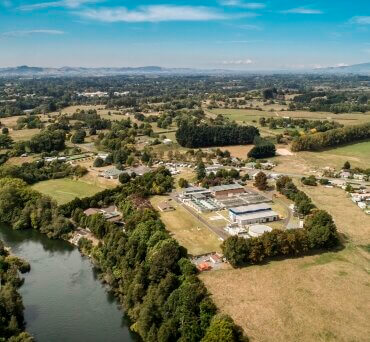
Aerial view of Waiora Water Treatment Plant
Water or H2O: a clear liquid without colour or taste, falls from the sky as rain, comes from the mountains as melted snow and covers about 70 per cent of the earth’s surface. Senior writer Mary Anne Gill explains why we should care about this life-giving compound, particularly this month.
Hamilton City Council’s Rhys Stevenson in the process of cleaning out the Waiora plant intakes of Waikato River waste before the water goes through the Hamilton Treatment Station. Across the river is Hamilton Gardens. Photo: Mary Anne Gill
It would be all too easy to ignore water until the toilet doesn’t flush or nothing comes out of the tap.
Our rural neighbours deal with it regularly. They dread the word drought because without water there is no life which is why the decisions our communities make over the next month about water are so important.
At the Waiora plant – a name which means “the purest form of water, the source of life and wellbeing” – Fiona Sutton and Karl Hjelmstrom from Hamilton City Council are about to take us on a tour.
Sutton, the head of operations for Three Waters – storm, waste and drinking – is a Waikato University graduate in law and science.
Her team’s job is to extract water from the Waikato River and provide clean, safe drinking water for Hamiltonians and then treat the city’s wastewater before it goes back into the river.

Hamilton City Council’s Rhys Stevenson cleans out the Waiora plant intakes of Waikato River waste before the water goes through the Hamilton Treatment Station. Photo: Mary Anne Gill
Finance Minister Robert Muldoon opened the Hamilton Water Treatment Plant, next to the Glenview Club, on August 24, 1971 and Hamilton mayor Michael Redman opened the station upgrade on February 16, 2007. Plaques mark the occasions.
Sutton and her team are usually anonymous unless the force of nature throws a spanner in the works – a major drought or a catastrophic event such as a volcanic eruption or an earthquake.
“Our systems are pretty resilient. We have back ups typically to ensure we can keep producing even if we need to maintain things and fix things.
“The team we have are pretty smart and are resilient in making sure the water keeps being provided for Hamiltonians so they can continue having their showers, cooking meals and drinking out of their drink bottles.
“Every single day, including Christmas Day, we have people out there collecting samples and testing the water is clean and safe to drink,” she says.

Fiona Sutton, left, and Karl Hjelmstrom inside the water treatment station where the water is being pumped up from the Waikato River. Photo: Mary Anne Gill
As part of community consultation about the future of water services in the city, the council this month opened the plant’s doors to the public for an unprecedented show and tell.
“We are very keen to tell our story to explain to people the important work that does happen because we’re really proud of it,” says Sutton, who has been in her current job for three years.
Hjelmstrom, an engineer, is the Waiora plant team leader who was born and raised around Hamilton, joined the city council and is back after stints at Waipā and Tauranga councils.
“I came back to my favourite place – the Waiora Treatment Plant.”
His team controls, pushes the buttons and does the monitoring for the plant which in its heyday would have had three manned shifts, 24 hours a day but is now down to semi-automated with a team of six.
“They respond to the alarms, they’re holding the babies at night,” he says.

Water goes through screening before the sedimentation process at the Waiora Water Treatment Plant. Photo: Mary Anne Gill
Hamilton’s drinking water comes from the Waikato River.
“We’re blessed to have our taonga, our river,” says Hjelmstrom.
“It is very clean, the best I’ve seen it, clear and beautiful. It’s a very stable water resource for us.”
It is screened twice, firstly at the intakes through coarse vertical bars which go up and down to remove leaves, weeds etc.
At the intake, across the river, is Hamilton Gardens with the Italian Renaissance Garden roof clearly visible.
“We try and remove what we can before we pump it into the clarifiers,” he says.
At the clarifiers they add polymer and aluminium sulphate “the magic ingredient” which settles things that gravity does not. The resulting sludge goes to the sewerage plant and the water continues through to sand filtration where any remaining nasties are taken out.
Then it is onto ultraviolet disinfection, adding chlorine, fluoride and lime – lime to correct the pH (potential of hydrogen) level – and porous carbon to remove any dissolved contaminants.

Porous carbon to remove any dissolved contaminants at Hamilton Water Treatment Plant 2025
It leaves the pumping station through one pipe and onto Hamilton’s nine reservoirs which store 123 million litres of water for the city’s 60,000 properties and other neighbouring properties such as Tamahere and Matangi in Waikato district.
“We’ve got a lot of water out there,” says Hjelmstrom with a look of satisfaction.
See: Water strength in numbers.
See: Facts at a glance
See: Changing the game for good
See: Feedback sought on city options
See: Water partnership means equal say

Water goes through screening before the sedimentation process at the Waiora Water Treatment Plant. Photo: Mary Anne Gill

Hamilton Waiora Water Treatment Plant 2025









